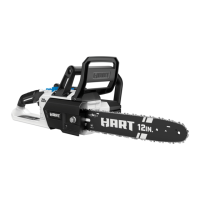2 – English
GENERAL POWER TOOL SAFETY WARNINGS
WARNING
Readallsafetywarningsandallinstructions.
Failure to follow the warnings and instruc-
tionsmayresultinelectricshock,fireand/or
serious injury.
Save all warnings and instructions for future
reference.
Theterm“powertool”inthewarnings
referstoyourmains-operated(corded)powertool
orbattery-operated(cordless)powertool.
WORK AREA SAFETY
Keep work area clean and well lit. Cluttered
ordarkareasinviteaccidents.
Do not operate power tools in explosive at-
mospheres, such as in the presence of flam-
mable liquids, gases or dust. Power tools cre-
atesparkswhichmayignitethedustorfumes.
Keep children and bystanders away while
operating a power tool.
Distractionscancause
you to lose control.
ELECTRICAL SAFETY
Power tool plugs must match the outlet.
Never modify the plug in any way. Do not use
any adapter plugs with earthed (grounded)
power tools.
Unmodifiedplugsandmatching
outletswillreduceriskofelectricshock.
Avoid body contact with earthed or grounded
surfaces such as pipes, radiators, ranges and
refrigerators.
Thereisanincreasedriskofelec-
tricshockifyourbodyisearthedorgrounded.
Do not expose power tools to rain or wet
conditions.
Waterenteringa power tool will
increasetheriskofelectricshock.
Do not abuse the cord. Never use the cord
for carrying, pulling or unplugging the power
tool. Keep cord away from heat, oil, sharp
edges or moving parts.
Damagedorentangled
cordsincreasetheriskofelectricshock.
When operating a power tool outdoors, use
an extension cord suitable for outdoor use.
Useofacordsuitableforoutdoorusereduces
theriskofelectricshock.
If operating a power tool in a damp location
is unavoidable, use a ground fault circuit
interrupter (GFCI) protected supply.
Useofa
GFCIreducestheriskofelectricshock.
PERSONAL SAFETY
Stay alert, watch what you are doing and
use common sense when operating a power
tool. Do not use a power tool while you are
tired or under the influence of drugs, alcohol
or medication.
Amomentofinattentionwhile
operatingpower tools may resultinserious
personalinjury.
Use personal protective equipment. Always
wear eye protection.
Protective equipment
suchasdustmask,non-skidsafetyshoes,hard
hat,orhearingprotectionusedforappropriate
conditionswillreducepersonalinjuries.
Prevent unintentional starting. Ensure the
switch is in the off-position before connect-
ing to power source and/or battery pack,
picking up or carrying the tool.
Carryingpower
toolswithyourfingerontheswitchorenergis-
ingpowertoolsthathavetheswitchoninvites
accidents.
Remove any adjusting key or wrench before
turning the power tool on.
Awrenchorakey
leftattachedtoarotatingpartofthepowertool
mayresultinpersonalinjury.
Do not overreach. Keep proper footing and
balance at all times.
Thisenablesbettercontrol
ofthepowertoolinunexpectedsituations.
Dress properly. Do not wear loose clothing or
jewellery. Keep your hair, clothing and gloves
away from moving parts.
Looseclothes,jewel-
leryorlonghaircanbecaughtinmovingparts.
If devices are provided for the connection of
dust extraction and collection facilities, en-
sure these are connected and properly used.
Useofdustcollectioncanreducedust-related
hazards.
Do not let familiarity gained from frequent
use of tools allow you to become complacent
and ignore tool safety principles.
Acareless
actioncancausesevereinjurywithinafraction
ofasecond.

